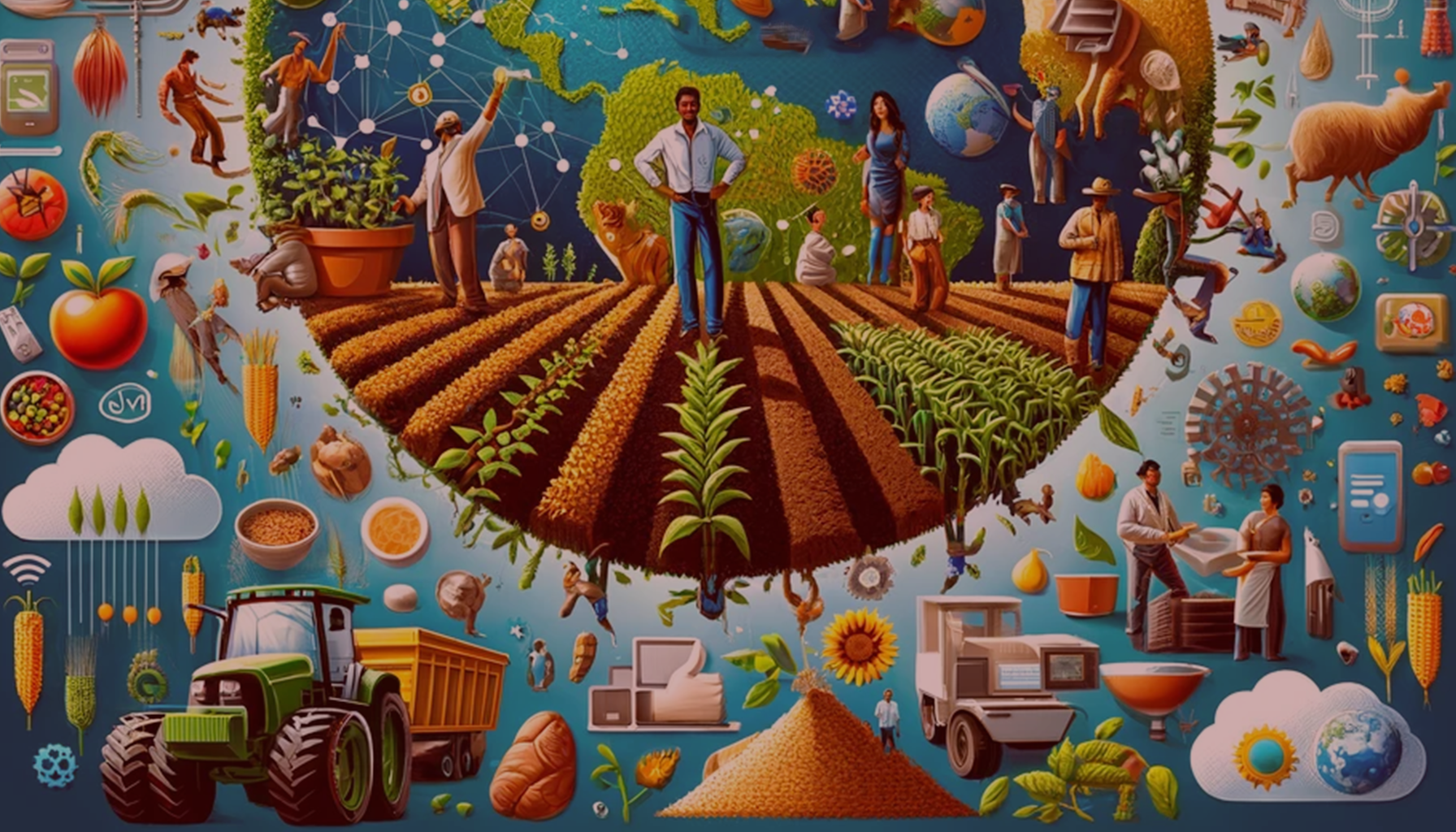Food security remains one of the most
pressing challenges of the 21st century, encompassing not just the sufficiency
of food production but also its distribution, accessibility, and nutritional
value. Technological innovations in agriculture, climate resilience,
sustainable farming practices, economic policies impacting food trade, food
waste management, and enhancement of nutritional security form a multi-layered
approach to addressing food security concerns.
Technological Innovations in Agriculture
Agricultural technology has undergone a
radical transformation in recent years. With the global population projected to
reach 9.7 billion by 2050, the United Nations’ Food and Agriculture
Organization (FAO) estimates that food production must increase by
approximately 70%. Technological innovations play a pivotal role in meeting
this target. Precision agriculture, for example, uses GPS and satellite imagery
to aid in farm management. Drones monitor crop health, soil quality, and water
levels, significantly optimizing resource use. Meanwhile, genetically modified
organisms (GMOs) can lead to crops that are not only more resistant to pests
and diseases but also more nutritious. In the United States, GMO crops have
been adopted extensively, increasing yields by 21% and reducing pesticides use
by 37%, according to a study by PLOS One.
Artificial intelligence (AI) is making a
profound impact, with machine learning models predicting crop yields, reducing
risks, and improving supply chain efficiency. Robotics, too, are
revolutionizing farming with automated harvesters and planters reducing the
need for labor, a significant boon as the agricultural sector faces workforce
shortages.
Climate Resilience and Sustainable Farming Practices
The Intergovernmental Panel on Climate
Change (IPCC) has warned of the severe impacts of climate change on food
production. Sustainable farming practices, such as crop diversification,
conservation agriculture, and agroforestry, are thus not just beneficial but
necessary for climate resilience. These practices help preserve essential
ecosystems, reduce dependency on chemical fertilizers, and improve soil health.
For example, conservation agriculture has tripled the yield in some regions of
Africa, as per the FAO.
Adopting sustainable practices often
requires a paradigm shift in farmer behavior and substantial initial
investment. However, the long-term benefits—improved soil health, water
conservation, and resilience to extreme weather events—far outweigh the initial
costs. Agroecology, which integrates principles of ecology into agricultural
production, is being promoted by various international bodies as a means to
both mitigate and adapt to climate change while maintaining productivity.
Impact of Economic Policies on Food Trade
Economic policies can have far-reaching
impacts on food security. Subsidies, tariffs, and trade agreements directly
influence food prices and availability. The World Trade Organization (WTO)
promotes free trade, which can lower food prices and increase availability.
However, this can also lead to vulnerabilities, as seen when countries rely too
heavily on global markets for their food supply, making them susceptible to
price volatility. According to the World Bank, the global food price index rose
by 8% between 2020 and 2021, exacerbating food insecurity in poorer nations.
Protectionist policies, while safeguarding
domestic agriculture, can distort global markets. For example, when India
banned rice exports in 2008, it led to a panic and skyrocketing price on the
global market. The challenge lies in balancing support for domestic agriculture
with the need to maintain stable global food markets.
Food Waste Management and Reduction
Food waste is a critical issue in food
security. The FAO estimates that one-third of all food produced globally is
lost or wasted, which equates to about 1.3 billion tons per year. Food waste
not only represents a loss of economic value but also contributes to greenhouse
gas emissions when it decomposes in landfills. Strategies for managing food
waste include improving food storage and transport to prevent spoilage, better
forecasting demand, and consumer education campaigns to reduce at-home waste.
Developed countries tend to waste more food
at the consumer level, while in developing countries, structural issues such as
poor infrastructure and storage facilities are the main contributors to food
loss. Reducing food waste can relieve pressure on food production systems,
decrease the need for land conversion for agriculture, and lower greenhouse gas
emissions.
Enhancing Nutritional Security and Food Accessibility
Nutritional security is an integral part of
food security. It's not enough to just provide sufficient calories; diets must
also meet the nutritional needs of populations. Malnutrition, including both
undernutrition and overnutrition, affects millions worldwide. The Global
Nutrition Report 2022 indicated that 149 million children under five years of
age are stunted, while 40 million are overweight. Biofortification, the process
of breeding crops to increase their nutritional value, can be a cost-effective
way of improving public health. The HarvestPlus program has successfully
developed biofortified crops with higher levels of vitamins and minerals,
benefiting over 38 million people in 30 countries.
Accessibility is another critical
component. Local food systems need strengthening to ensure that food is not
only available but also affordable and accessible to all segments of the
population. Initiatives such as community-supported agriculture (CSA) and
farmers' markets have gained traction, supporting local farmers and reducing
the carbon footprint associated with long-distance food transport.
Cold Storage and Cold Supply Chain
Cold storage and the cold supply chain are
vital components of global food security, playing a critical role in ensuring
that perishable goods reach consumers in optimal condition, thus reducing waste
and improving food safety.
The cold chain logistics market size was
valued at USD 280.9 billion in 2022 and is expected to expand at a compound
annual growth rate (CAGR) of 16.39% from 2023 to 203, according to Astute
Analytica. This growth highlights the increasing importance of refrigerated
storage and transportation in maintaining the quality and longevity of food
products. Efficient cold storage facilities enable the stabilization of food
supplies by allowing perishable items to be stored for longer periods, which
can be crucial in balancing seasonal production with year-round demand. The
Global Cold Chain Alliance (GCCA) reported that the capacity of refrigerated
warehouses worldwide saw a growth of 16.7% from 2018 to 2022, reflecting an
increase in the investment within the sector.
Moreover, the cold supply chain is pivotal
in preventing food loss, which is significant given that the FAO estimates
nearly 14% of food produced is lost between harvest and retail. Proper cold
chain management can significantly reduce this figure. For instance,
refrigerated transport is essential for maintaining the cold chain during
distribution, and advancements such as real-time temperature monitoring during
transit can reduce spoilage rates.
However, there are challenges, especially
in developing countries, where the World Bank highlights that only about 10% of
perishable foods are refrigerated, compared to more than 90% in developed
countries. This discrepancy points to the need for investment in cold chain
infrastructure to improve food security and reduce waste.
To address these disparities and enhance
global food security, investments in cold chain technology and infrastructure
are required. This involves not just physical assets but also training for
local workforces in handling and maintaining the cold chain, emphasizing the
importance of global knowledge transfer and financial support for such
initiatives. Integrating cold storage and cold supply chains with other food
security measures can help ensure that the increase in food production required
to feed the growing population is not undermined by losses post-harvest.
Building more resilient food systems will rely heavily on our ability to
maintain the quality and safety of food from farm to table, making cold chain
solutions an indispensable part of the equation.
Conclusion
Food security is a complex issue requiring
a coordinated approach that integrates technological innovation, sustainable
practices, informed economic policies, food waste reduction, and a focus on
nutrition. Each component plays a role in ensuring that the global population
can access sufficient, nutritious, and sustainable food supplies.
As we look forward, the goal is not only to
produce more food but to do so in a way that is environmentally sustainable,
economically viable, and socially just. It is an intricate balance, but with
concerted effort and continuous innovation, it is within our reach. The stakes
are high, as food security is inextricably linked to political stability,
health outcomes, and environmental sustainability. It is a global challenge
that demands global solidarity and action.
Harnessing the Power of Diverse Global Insights and Revolutionary Research Techniques
At Astute Connect, we pride ourselves on our global market research teams, whose diverse expertise spans continents and industries. Our innovative methodologies and unique perspectives converge to deliver bespoke solutions, tailored to meet every nuance of your business needs, ensuring not just growth, but a trajectory towards industry leadership
Contact Us


